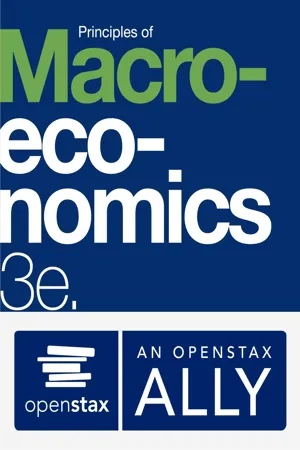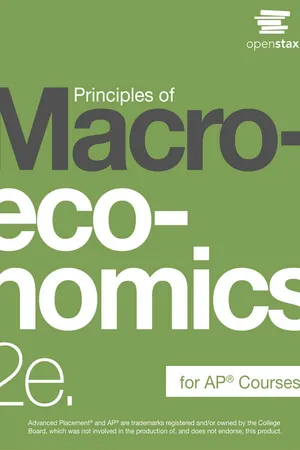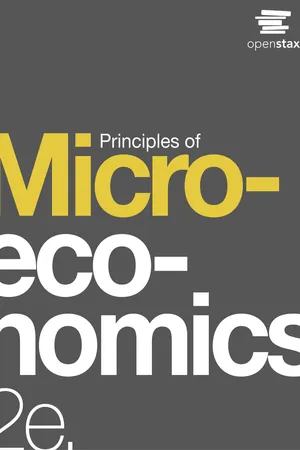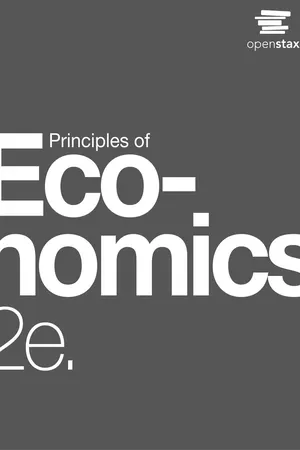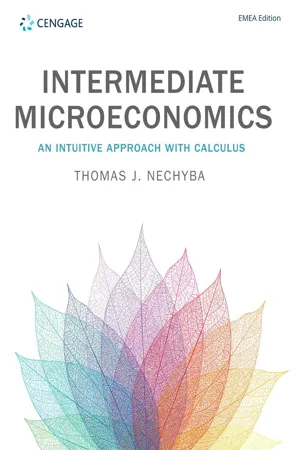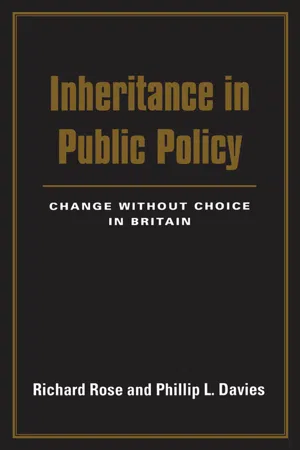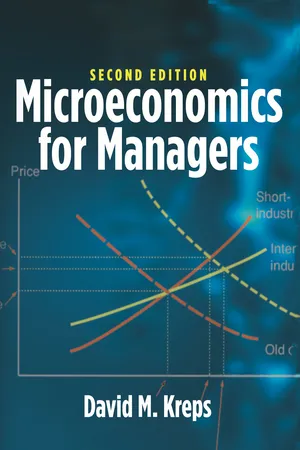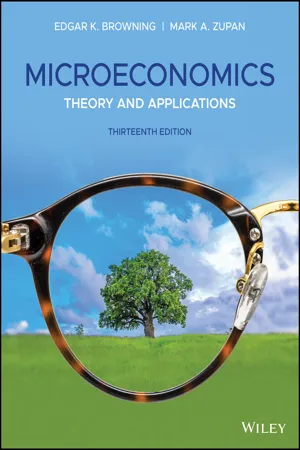Economics
Budget Constraint
A budget constraint represents the limit on the consumption choices of an individual or a firm, based on their income and the prices of goods and services. It illustrates the trade-offs between different goods and services that can be purchased within the constraints of a given budget. The budget constraint is typically depicted graphically as a budget line showing the combinations of goods that can be afforded.
Written by Perlego with AI-assistance
Related key terms
1 of 5
9 Key excerpts on "Budget Constraint"
- eBook - PDF
- David Shapiro, Daniel MacDonald, Steven A. Greenlaw(Authors)
- 2022(Publication Date)
- Openstax(Publisher)
Because people live in a world of scarcity, they cannot have all the time, money, possessions, and experiences they wish. Neither can society. This chapter will continue our discussion of scarcity and the economic way of thinking by first introducing three critical concepts: opportunity cost, marginal decision making, and diminishing returns. Later, it will consider whether the economic way of thinking accurately describes either how we make choices and how we should make them. 2.1 How Individuals Make Choices Based on Their Budget Constraint LEARNING OBJECTIVES By the end of this section, you will be able to: • Calculate and graph Budget Constraints • Explain opportunity sets and opportunity costs • Evaluate the law of diminishing marginal utility • Explain how marginal analysis and utility influence choices Consider the typical consumer’s budget problem. Consumers have a limited amount of income to spend on the things they need and want. Suppose Alphonso has $10 in spending money each week that he can allocate between bus tickets for getting to work and the burgers that he eats for lunch. Burgers cost $2 each, and bus tickets are 50 cents each. We can see Alphonso's budget problem in Figure 2.2. 28 2 • Choice in a World of Scarcity Access for free at openstax.org FIGURE 2.2 The Budget Constraint: Alphonso’s Consumption Choice Opportunity Frontier Each point on the Budget Constraint represents a combination of burgers and bus tickets whose total cost adds up to Alphonso’s budget of $10. The relative price of burgers and bus tickets determines the slope of the Budget Constraint. All along the budget set, giving up one burger means gaining four bus tickets. The vertical axis in the figure shows burger purchases and the horizontal axis shows bus ticket purchases. If Alphonso spends all his money on burgers, he can afford five per week. ($10 per week/$2 per burger = 5 burgers per week.) However, if he does this, he will not be able to afford any bus tickets. - Steven A. Greenlaw, Timothy Taylor, David Shapiro(Authors)
- 2017(Publication Date)
- Openstax(Publisher)
Neither can society. This chapter will continue our discussion of scarcity and the economic way of thinking by first introducing three critical concepts: opportunity cost, marginal decision making, and diminishing returns. Later, it will consider whether the economic way of thinking accurately describes either how we make choices and how we should make them. 2.1 | How Individuals Make Choices Based on Their Budget Constraint By the end of this section, you will be able to: • Calculate and graph Budget Constraints • Explain opportunity sets and opportunity costs • Evaluate the law of diminishing marginal utility • Explain how marginal analysis and utility influence choices Consider the typical consumer’s budget problem. Consumers have a limited amount of income to spend on the things they need and want. Suppose Alphonso has $10 in spending money each week that he can allocate between bus tickets for getting to work and the burgers that he eats for lunch. Burgers cost $2 each, and bus tickets are 50 cents each. We can see Alphonso's budget problem in Figure 2.2. Figure 2.2 The Budget Constraint: Alphonso’s Consumption Choice Opportunity Frontier Each point on the Budget Constraint represents a combination of burgers and bus tickets whose total cost adds up to Alphonso’s budget of $10. The relative price of burgers and bus tickets determines the slope of the Budget Constraint. All along the budget set, giving up one burger means gaining four bus tickets. 28 Chapter 2 | Choice in a World of Scarcity This OpenStax book is available for free at http://cnx.org/content/col23729/1.3 The vertical axis in the figure shows burger purchases and the horizontal axis shows bus ticket purchases. If Alphonso spends all his money on burgers, he can afford five per week. ($10 per week/$2 per burger = 5 burgers per week.) However, if he does this, he will not be able to afford any bus tickets. Point A in the figure shows the choice (zero bus tickets and five burgers).- eBook - PDF
- Steven A. Greenlaw, Timothy Taylor, David Shapiro(Authors)
- 2017(Publication Date)
- Openstax(Publisher)
Neither can society. This chapter will continue our discussion of scarcity and the economic way of thinking by first introducing three critical concepts: opportunity cost, marginal decision making, and diminishing returns. Later, it will consider whether the economic way of thinking accurately describes either how we make choices and how we should make them. 2.1 | How Individuals Make Choices Based on Their Budget Constraint By the end of this section, you will be able to: • Calculate and graph Budget Constraints • Explain opportunity sets and opportunity costs • Evaluate the law of diminishing marginal utility • Explain how marginal analysis and utility influence choices Consider the typical consumer’s budget problem. Consumers have a limited amount of income to spend on the things they need and want. Suppose Alphonso has $10 in spending money each week that he can allocate between bus tickets for getting to work and the burgers that he eats for lunch. Burgers cost $2 each, and bus tickets are 50 cents each. We can see Alphonso's budget problem in Figure 2.2. Figure 2.2 The Budget Constraint: Alphonso’s Consumption Choice Opportunity Frontier Each point on the Budget Constraint represents a combination of burgers and bus tickets whose total cost adds up to Alphonso’s budget of $10. The relative price of burgers and bus tickets determines the slope of the Budget Constraint. All along the budget set, giving up one burger means gaining four bus tickets. 28 Chapter 2 | Choice in a World of Scarcity This OpenStax book is available for free at http://cnx.org/content/col12170/1.7 The vertical axis in the figure shows burger purchases and the horizontal axis shows bus ticket purchases. If Alphonso spends all his money on burgers, he can afford five per week. ($10 per week/$2 per burger = 5 burgers per week.) However, if he does this, he will not be able to afford any bus tickets. Point A in the figure shows the choice (zero bus tickets and five burgers). - eBook - PDF
- Steven A. Greenlaw, Timothy Taylor, David Shapiro(Authors)
- 2017(Publication Date)
- Openstax(Publisher)
Neither can society. This chapter will continue our discussion of scarcity and the economic way of thinking by first introducing three critical concepts: opportunity cost, marginal decision making, and diminishing returns. Later, it will consider whether the economic way of thinking accurately describes either how we make choices and how we should make them. 2.1 | How Individuals Make Choices Based on Their Budget Constraint By the end of this section, you will be able to: • Calculate and graph Budget Constraints • Explain opportunity sets and opportunity costs • Evaluate the law of diminishing marginal utility • Explain how marginal analysis and utility influence choices Consider the typical consumer’s budget problem. Consumers have a limited amount of income to spend on the things they need and want. Suppose Alphonso has $10 in spending money each week that he can allocate between bus tickets for getting to work and the burgers that he eats for lunch. Burgers cost $2 each, and bus tickets are 50 cents each. We can see Alphonso's budget problem in Figure 2.2. Figure 2.2 The Budget Constraint: Alphonso’s Consumption Choice Opportunity Frontier Each point on the Budget Constraint represents a combination of burgers and bus tickets whose total cost adds up to Alphonso’s budget of $10. The relative price of burgers and bus tickets determines the slope of the Budget Constraint. All along the budget set, giving up one burger means gaining four bus tickets. 28 Chapter 2 | Choice in a World of Scarcity This OpenStax book is available for free at http://cnx.org/content/col12190/1.4 The vertical axis in the figure shows burger purchases and the horizontal axis shows bus ticket purchases. If Alphonso spends all his money on burgers, he can afford five per week. ($10 per week/$2 per burger = 5 burgers per week.) However, if he does this, he will not be able to afford any bus tickets. Point A in the figure shows the choice (zero bus tickets and five burgers). - eBook - PDF
- Steven A. Greenlaw, Timothy Taylor, David Shapiro(Authors)
- 2017(Publication Date)
- Openstax(Publisher)
However, the lesson of sunk costs is to ignore them and make decisions based on what will happen in the future. From a Model with Two Goods to One of Many Goods The Budget Constraint diagram containing just two goods, like most models used in this book, is not realistic. After all, in a modern economy people choose from thousands of goods. However, thinking about a model with many goods is a straightforward extension of what we discussed here. Instead of drawing just one Budget Constraint, showing the tradeoff between two goods, you can draw multiple Budget Constraints, showing the possible tradeoffs between many different pairs of goods. In more advanced classes in economics, you would use mathematical equations that include many possible goods and services that can be purchased, together with their quantities and prices, and show how the total spending on all goods and services is limited to the overall budget available. The graph with two goods that we presented here clearly illustrates that every choice has an opportunity cost, which is the point that does carry over to the real world. 2.2 | The Production Possibilities Frontier and Social Choices By the end of this section, you will be able to: • Interpret production possibilities frontier graphs • Contrast a Budget Constraint and a production possibilities frontier • Explain the relationship between a production possibilities frontier and the law of diminishing returns • Contrast productive efficiency and allocative efficiency • Define comparative advantage Just as individuals cannot have everything they want and must instead make choices, society as a whole cannot have everything it might want, either. This section of the chapter will explain the constraints society faces, using a model called the production possibilities frontier (PPF). There are more similarities than differences between individual choice and social choice. As you read this section, focus on the similarities. - eBook - PDF
Intermediate Microeconomics
An Intuitive Approach with Calculus
- Thomas Nechyba(Author)
- 2018(Publication Date)
- Cengage Learning EMEA(Publisher)
A proposal is made to ask consumers to pay exactly the amount they paid in sugary drinks taxes as a monthly lump sum payment. Ignoring for the moment the difficulty of gathering the necessary information for implementing this proposal, how would this change the average consumer’s Budget Constraint? B. State the equations for the Budget Constraints you derived in 2.6A(a) and 2.6A(b), letting sugary drinks be denoted by x 1 and other consumption by x 2 . * conceptually challenging † solutions in Study Guide Copyright 2018 Cengage Learning. All Rights Reserved. May not be copied, scanned, or duplicated, in whole or in part. Due to electronic rights, some third party content may be suppressed from the eBook and/or eChapter(s). Editorial review has deemed that any suppressed content does not materially affect the overall learning experience. Cengage Learning reserves the right to remove additional content at any time if subsequent rights restrictions require it. 28 Economic Circumstances in Labour and Financial Markets Chapter 3 Before money can be spent on consumer goods, it must first be generated through some form of economic activity. For most of us, this activity involves work, or the giving up of our time in return for pay. Alterna-tively, we might generate money by borrowing or by cashing in savings from savings accounts, investment funds, property investments or other assets. In each of these scenarios, we are giving up some endowment , something whose value is determined by prices in the economy, to receive money for consumption. We are, in effect, trading an endowment in order to generate the money that can be treated as a fixed budget when we go into a shop for hoodies and jeans. Our economic circumstances in work/leisure and savings/borrowing decisions are shaped by the en-dowment that we bring to the table as well as the prices that the endowment commands in the market. - eBook - PDF
- R. Po-chia Hsia(Author)
- 1990(Publication Date)
- Yale University Press(Publisher)
Advocates of a constitutional limit upon public expenditure believe that if spending is not thus constrained, the cumulative effects of the choices of hyperactive politicians cannot be sustained econom-ically. In Britain the ceiling imposed by economic growth is lower than in the average advanced industrial nation, because growth in the British economy has been below the international average. The sequencing of events loosens economic constraints, for the amount of revenue obtained by government in a given year from economic growth is only known after the fact, whereas the choices that politicians make about the year's spending commitments are based upon ex ante expectations of economic growth. There are always a multiplicity of forecasts of the state of the economy in the months ahead, each based upon varying theoretical and empirical assumptions and producing significantly different results. Differences in forecasts thus give politicians some discretion in choosing the revenue estimate to be taken as the constraint upon choice. A rosy scenario allows much more scope for choice than a dire forecast. Projecting past trends into the future is the simplest way to form expectations of public revenue. However, this is risky because of the short-term ups and downs of the economic cycle, and over the years there are structural changes in the rate of economic growth. Statistical models of the future path of the economy can take into account the ups Economic Constraints on the Scope for Choice 147 and downs of economic cycles, but anticipating shocks from abroad is much more difficult, and such shocks are important as an open econ-omy is increasingly subject to international influences. Our expectations fluctuate too. In Victorian times there was a consensus that favored strict limitations upon activities of govern-ment. When the government claimed only a few percent of the national product, this was sometimes considered too much. - eBook - PDF
- David M. Kreps(Author)
- 2019(Publication Date)
- Princeton University Press(Publisher)
Part III Bang for the Buck: Optimization Under Constraint 10. The Utility-Maximizing Consumer The utility-maximizing consumer , who chooses subject to a Budget Constraint , is the basic economic model of individual behavior. This chapter presents this model and discusses its rationale and some empirical flaws. The chapter also serves as an introduction to methods for solving optimization problems under constraints and, in particular, to the concept of bang for the buck . In the models we’ve explored so far, the only entities making conscious choices have been firms, which choose production levels to maximize profit. But, in economics, other sorts of “actors” make choices. Preeminent among these are individuals, who choose how much to buy and consume, how much to save, how to invest those savings, where to work, how hard to work, and so forth. For a variety of purposes, including a better understanding firm behavior, we must model choices made by individuals. This chapter introduces the model of the utility-maximizing consumer , which economists use for this purpose. We eventually use this model as the foundation for modeling savings and investment choices, effort choices on the job, and so forth. It would better suit the variety of applications we have in mind to call this the model of the utility-maximizing person , but economists use the term consumer instead of person , and we follow suit. Indeed, in this chapter, all our illustrative examples concern a consumer choosing what to eat for lunch and, in places, how much money to leave in her pocket for future purchases. So, as far as our examples are concerned, the term consumer is entirely appropriate. But do not be misled by this; we apply this model much more broadly in later chapters. 10.1. The Model: Utility Maximization The model of the utility-maximizing consumer is conceptually quite simple. A set of consumption bundles are offered to the consumer, from which she must choose one. - eBook - PDF
Microeconomics
Theory and Applications
- Edgar K. Browning, Mark A. Zupan(Authors)
- 2019(Publication Date)
- Wiley(Publisher)
3 Note that we are defining income (and, later, consumption) as a “flow” variable—the amount of income the student receives per week—as opposed to a “stock” variable—the wealth at the disposal of the student. • The Budget Constraint 53 line, such as G, involves a total outlay that is smaller than the student’s weekly income. Any point outside the line, such as H (7 clothing units and 6 meals), requires an outlay larger than the student’s weekly income and is therefore beyond reach. Consequently, the budget line reinforces the concept of scarcity developed in Chapter 1: the student cannot have unlimited amounts of everything, so choices among possible options, which are shown by the budget line, must be made. Geometry of the Budget Line A thorough understanding of the geometry of a budget line will prove helpful later on. Note that the intercepts with the axes show the maximum amount of one good that can be pur- chased if none of the other is bought. Point A indicates that 10 meals can be bought if income is devoted to meals alone. The vertical intercept equals the student’s weekly income (I) divided by the price of meals ( / , /( / )] ) I P M or [$ $ meal meals 90 9 10 , since $90 permits the purchase of 10 meals costing $9 each. Similarly, point Z equals weekly income divided by the price of clothing ( / , [ ( / )] ) I P C or $ / $ clothing unit clothing units 90 18 5 . The budget line’s slope indicates how many meals the student must give up to buy one more clothing unit. For example, the slope at point B in Figure 3.8 is ΔM / ΔC, or −2 meals per 1 clothing unit, indicating that a move from B to W involves sacrificing two meals to gain an additional clothing unit. (Because AZ is a straight line, the slope is constant at −2 meals per 1 clothing unit at all points along the line.) Note that the slope indicates the relative cost of each good. To get one more clothing unit, the student must give up two meals.
Index pages curate the most relevant extracts from our library of academic textbooks. They’ve been created using an in-house natural language model (NLM), each adding context and meaning to key research topics.
